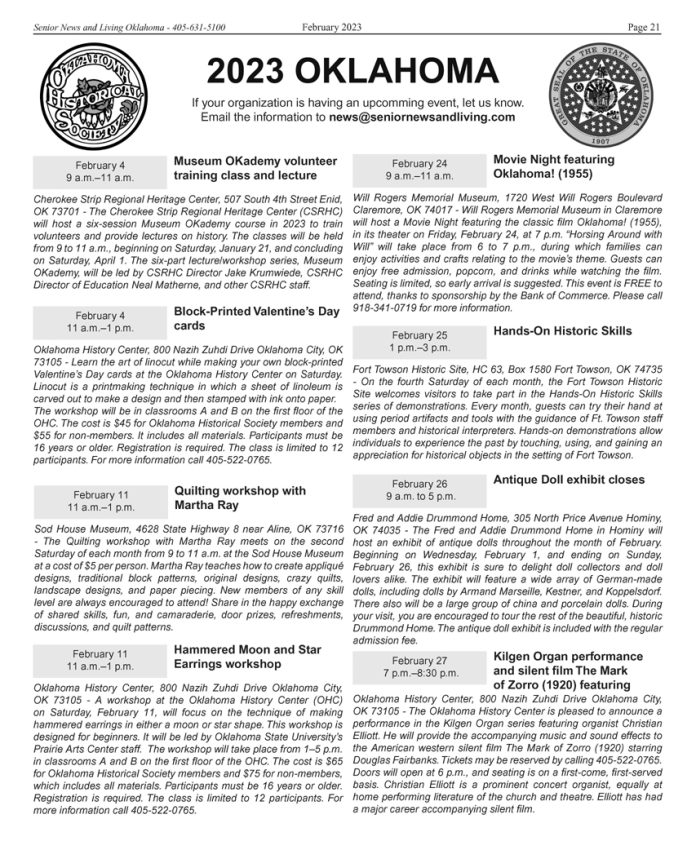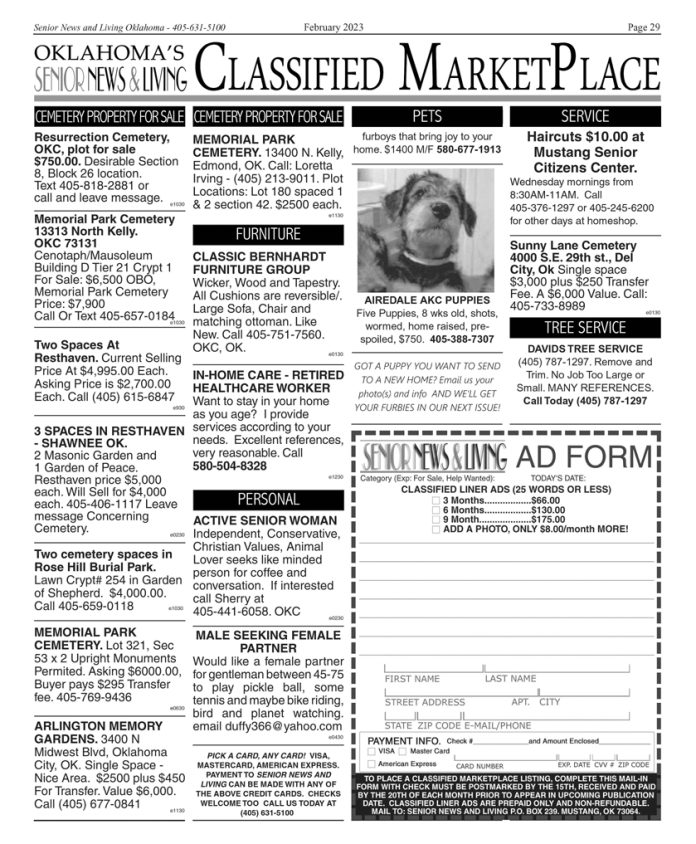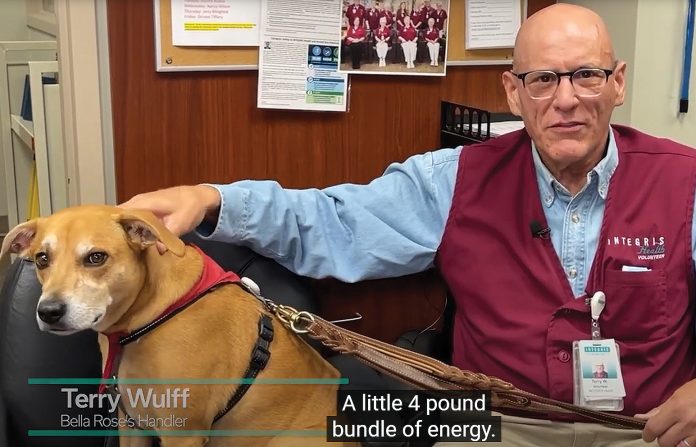If your organization is having an upcoming event, let us know. Email the information to news@okveterannews.com
MAKE A DIFFERENCE IN A LONG-TERM CARE FACILITY
The start of a new year often brings thoughts of renewal, new goals, a fresh start. While planning for this year, if you want to make a difference think about volunteering as a Long-Term Care Ombudsman (LTCO). Many people volunteer during the holiday season, but volunteers are needed every day of the year and LTCO volunteers are in high demand. A LTCO volunteer can assist residents in Nursing Facilities, Assisted Living Facilities, Residential Care Facilities, and Intermediate Care Facilities for Individuals with Intellectual Disabilities. Volunteers make weekly visits to field resident complaints and help residents advocate for resolution for those complaints. If you are passionate about giving a voice to members of our most vulnerable population this is the opportunity you’ve been waiting for.
If a weekly commitment doesn’t fit in your schedule, consider contacting a facility near you and ask how you can support residents. Facilities can be located by searching online at https://www.medicare.gov/. There are many opportunities to help make a difference in Long-Term Care communities. If you are motivated by helping others, make the call today.
If you have a loved one in a Long-Term Care facility and have any questions regarding care or concerns you may have, you can contact an Ombudsman to assist you.
Areawide Aging Agency’s Long-Term Care Ombudsman Program advocates for the needs of residents in LTC facilities serving Canadian, Cleveland, Logan, and Oklahoma Counties. You may contact us at (405)942-8500 and ask to speak with an Ombudsman, visit our website at https://www.areawideaging.org/ or find us on Facebook.
OHC Presents February Kilgen Organ Performance Featuring “The Mark of Zorro”
The Oklahoma History Center is pleased to announce a performance in the Kilgen Organ series featuring organist Christian Elliott. He will provide the accompanying music and sound effects to the American western silent film “The Mark of Zorro” (1920) starring Douglas Fairbanks. This performance will take place on Monday, February 27, 2023, from 7 to 8:30 p.m. Tickets are $10 for Oklahoma Historical Society members and $20 for non-members, and may be reserved by calling 405-522-0765. Doors will open at 6 p.m., and seating is on a first-come, first-served basis.
Christian Elliott is a prominent concert organist, equally at home performing literature of the church and theater. Elliott’s career has included extensive silent film accompaniment at venues including the Academy of Motion Picture Arts and Sciences, the Packard Foundation’s Stanford Theatre and the University of California, Los Angeles. Elliott was privileged to be mentored by several world-renowned organists and worked extensively with the “dean” of silent film accompaniment, Gaylord Carter. Elliott was named Organist of the Year by the American Theatre Organ Society in 2009.
SNL CENTENARIANS OF OK
Annie Laurie (Ivey) Whited
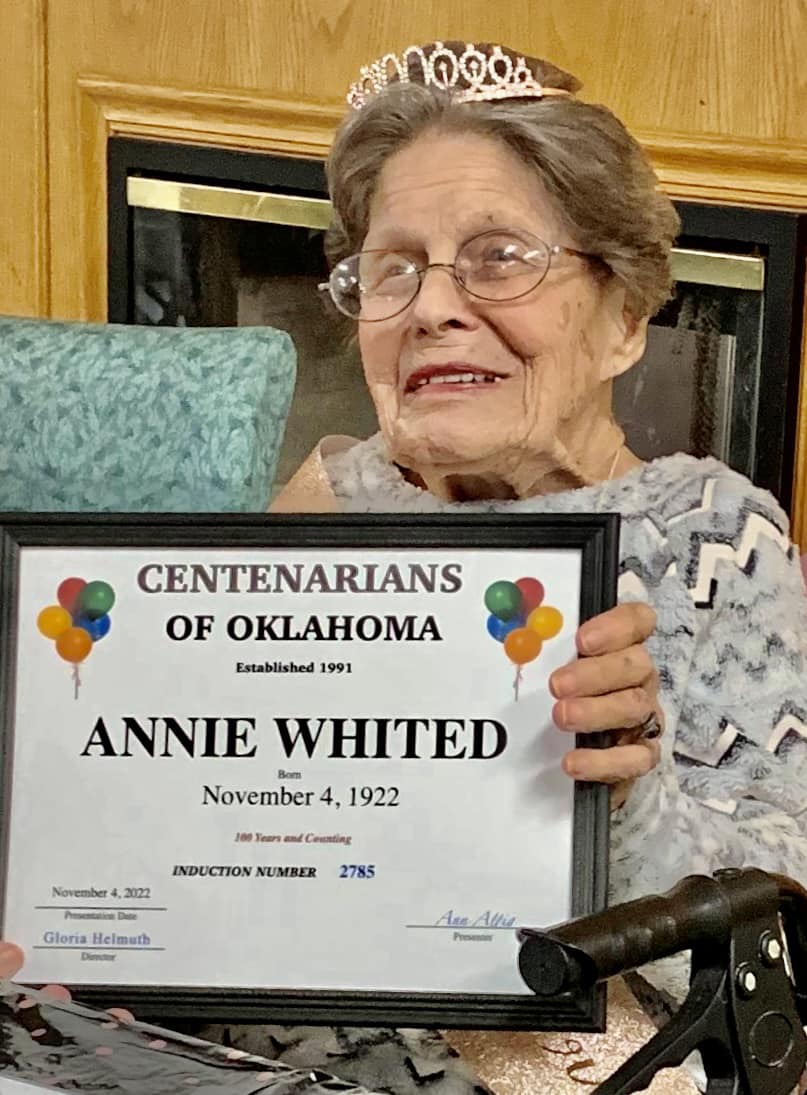
Annie Laurie (Ivey) Whited of Noble was manager of the gift & book shop at the OU Continuing Ed Center before retiring in 1984. She attended Crosspointe Church in Norman and was a member of the Army Officers’ Wives Club. Annie’s words of wisdom: “Love the Lord, exercise, eat well and love others!”
Anna Lee Kurtz
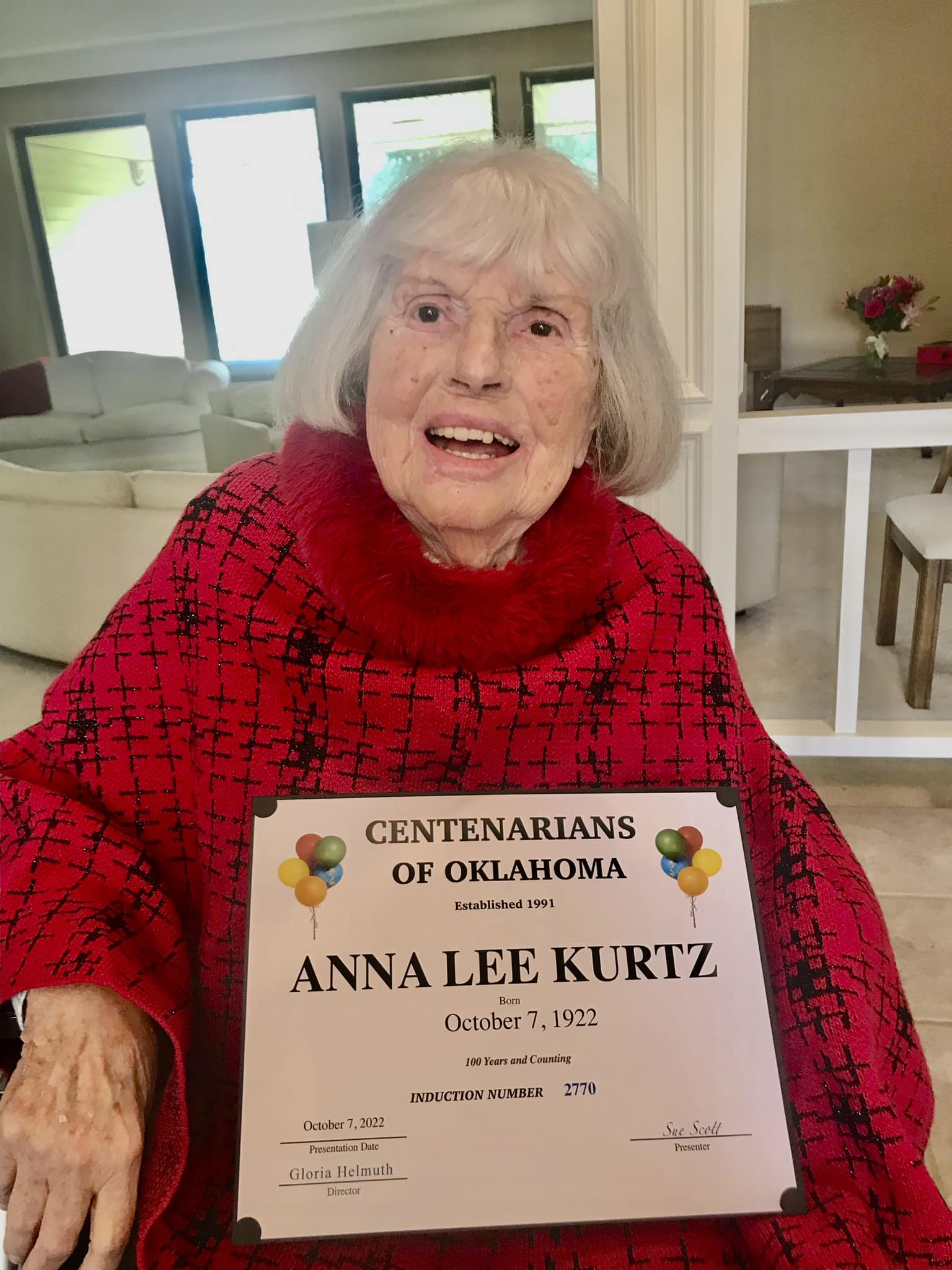
Anna Lee Kurtz of Oklahoma City is now a centenarian. She attended and volunteered at Catholic churches wherever she lived, volunteered with Meals on Wheels and the Homeless Shelter. Anna says “Stay active, be positive and always be willing to help others!”
LaVerne Cox Tucker

LaVerne Cox Tucker of Sweetwater actively engages in her hobbies of reading, quilting & crocheting. She resides in the house built at the turn of the century that she moved into as a new bride & is involved with the decisions of the farming & ranching with her son & grandson. The Tucker Home Place was declared an Oklahoma Centennial Farm in 2022. Four generations of Tuckers have farmed the 160 acres. LaVerne’s life advice: “Be honest and be true!”
Greg Schwem: I’m going full ‘Clint Eastwood’ on you, pickleball youngsters
by Greg Schwem

“Get off my pickleball court!”
I know, I know. That phrase may never reach pop culture status like, “Get off my lawn,” which curmudgeonly Clint Eastwood famously uttered in “Gran Torino” and, ultimately, became an ode to petulance and turf wars.
But, come on, when did these “kids” start playing the sport that was supposed to be reserved for old farts like me? Former “athletes” with knees that now creak, feet that swell and elbows that throb after completing simple tasks? Like getting out of bed. We took up pickleball because it’s the only sport left that, at our age, produces sweat but not a potential 911 call. If we’re too infirm for pickleball, all that’s left is bowling.
For a while, we were happy. We knew the one or two pickleball courts in our subdivisions would be empty when we rolled up with our posse of fellow retirees and snowbirds. Meanwhile, the Gen Z crowd jogged by, not even trying to hide their snickers and guffaws as they watched four guys flailing at a wiffleball, occasionally yelling, “KITCHEN” or “THREE TWO ON THE ONE” before launching a serve — an UNDERHAND serve. We didn’t care; we’d found our happy place, and, even better, knew it was created exclusively for us. Sort of like early bird dinner at Denny’s.
Or so we thought.
Now we fight for court space with those same Gen Zers, the ones who eventually stopped jogging, picked up paddles and decided to give America’s fastest growing sport a try. Oh, and they did more than try. While our medicated ointment was drying on our aching muscles, they were silently taking over. (STORY CONTINUES BELOW)

On a recent Friday evening at a suburban Chicago tennis club, it was hard to find any actual tennis players. Instead, more than 80 people, me included, converged for open play on tennis courts that had hastily been converted into pickleball courts via brightly colored tape that doubled as boundary lines.
As I waited for a court to open, I scanned the area and estimated at least half the players were younger than 35. The figure was probably higher; my deteriorating eyesight made it difficult to make out shapes on the outer courts.
What’s worse is that, in between drop spins and stacks (OK, I’ll stop with the terminology), they were discussing post-pickleball plans. Some talked of going out for drinks. Or dinner. At 9 p.m.!
After pickleball, the only thing I go out for is Advil.
Thankfully, in pickleball, younger does not necessarily mean better when it comes to skill. I have found the Gen Z set lacking in patience during an extended rally of cross-court dinks, preferring a smash when the ball is nowhere near at “smash level.” Gen Zers, if that sentence befuddles but also intrigues you, grab a paddle and join the fun.
But consider this your warning. “Fun” to grizzled pickleball veterans means you will most likely be on the receiving end of a pickleball hit with full force and aimed directly at your midsection.
It’s not that we hate you personally; rather, we are angry that our sport, almost overnight, doubled in popularity because a younger demographic wanted to be part of our playdates. And what are we supposed to do to exact revenge? Crash your MMOGs? (Massively Multiplayer Online Games). We don’t own Xboxes; we buy them for our grandchildren.
So, we’ll take out our frustrations on the pickleball court, specifically against you, bro with the backward baseball cap, baggy shorts and “Lollapalooza ’22” T-shirt, who took up pickleball because the courts were walking distance to his favorite karaoke bar. We’ll apologize when the point’s over.
Or maybe we won’t. Maybe we’ll do the snickering. Or maybe we’ll high-five our partners as we return to the baseline and get ready for the next point.
On second thought, it’s probably not a good idea if we high-five.
We might sprain something.
(Greg Schwem is a corporate stand-up comedian and author of two books: “Text Me If You’re Breathing: Observations, Frustrations and Life Lessons From a Low-Tech Dad” and the recently released “The Road To Success Goes Through the Salad Bar: A Pile of BS From a Corporate Comedian,” available at Amazon.com. Visit Greg on the web at www.gregschwem.com.
You’ve enjoyed reading, and laughing at, Greg Schwem’s monthly humor columns in Senior Living News. But did you know Greg is also a nationally touring stand-up comedian? And he loves to make audiences laugh about the joys, and frustrations, of growing older. Watch the clip and, if you’d like Greg to perform at your senior center or senior event, contact him through his website at www.gregschwem.com)
Hospital systems announce layoffs
Story by Bobby Anderson, RN, Staff Writer
The new year has brought a new round of hospital layoffs as healthcare systems nationwide deal with surging labor costs, shortages, and declining revenues.
Locally, the first two weeks of January saw layoffs from Integris Health as well as OU Health.
Integris announced it was cutting some 200 positions while OU announced an equal number of layoffs.
In a statement, OU health announced the layoffs would coincide with its planned restructuring.
“As part of the redesign, OU Health will move from a holding company to an operating company structure with duplicative services and positions being eliminated,” the statement read. “An estimated 200 positions will be reconfigured to the new structure, which integrates the organization into clinical business.”
Integris Health announced its reduction would be the result of a combination of cuts.
“Financial challenges are multifold, but some include a dramatic rise in expenses due to labor shortages and supply-chain disruptions, and significantly lower patient volumes compared to pre-pandemic days,” the statement read.
Integris laid off 140 positions and cut 60 vacant jobs, according to a spokeswoman.
The healthcare industry has suffered from nursing shortages and the winter’s omicron surge, forcing many organizations to turn to contract workers demanding higher rates.
The loss of Covid subsidies from the federal government also impacted the ability to keep up with rising labor costs.
Many systems find themselves in a counter-intuitive role of both cutting positions while trying to recruit and retain nurses.
OU Health announced its organizational redesign to complete the integration from its historic merger on July 1, 2021.
OU Health was created as the flagship comprehensive, integrated academic health system to improve the care and outcomes for all Oklahomans. As the state’s academic referral health system, OU Health plays the unique role of providing critical specialty services with access to advanced technology and expertise.
“OU Health needs to support and enhance the capabilities of the state’s vital rural and regional hospitals as the flagship academic referral center. All care that can remain in a community should remain local, but if the patient needs a higher level of care, OU Health is here to serve,” said OU Health President and CEO Richard Lofgren, M.D., MPH.
The organizational redesign and operational restructure will enable OU Health to improve efficiencies and grow its impact in the state and region as well as create a highly integrated, modern clinical platform, one that serves even more Oklahomans.
“In order to grow and adapt to industry changes, we need to perform in terms of the quality of our services, patient experience, and the efficiency and effectiveness of our processes,” Lofgren said. “Oklahoma needs the unique specialty and sub-specialty services we provide. We are positioned with dedicated physicians and staff to fully realize our special mission of clinical care, education, and research. We are committed to our role of continuing to improve the care and outcomes for the region and beyond.”
Both health systems are still actively hiring bedside nurses offering both recruitment and retention bonuses.
TINSELTOWN TALKS: Adrienne Barbeau – from musicals to monsters
By Nick Thomas
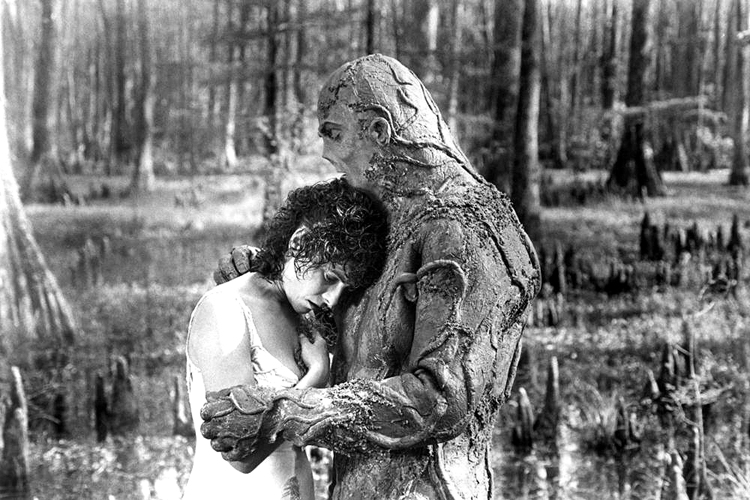
Before “Grease,” the hit 1978 movie, there was “Grease” the musical theater production first performed in Chicago in 1971 before moving to Broadway a year later for over 3,000 performances.
Adrienne Barbeau, who played Rizzo during the first five months of the show’s run, helped commemorate the 50th anniversary of the production as a co-editor of the 2022 book: “Grease, Tell Me More, Tell Me More – Stories from the Broadway Phenomenon That Started It All.” It features personal anecdotes from the Broadway cast and crew.
“It stemmed from a Zoom meeting that the original cast had when the pandemic first shut everything down,” recalled Barbeau from her home in Los Angeles. “The stories everybody told were just so delightful and touching and funny and most of them all new to me because I left the show early on.” (STORY CONTINUES BELOW)

Barbeau and two others involved in the production began assembling the stories.
“We sent out a questionnaire to over 100 actors, musicians, and crew members who had been involved in the show asking them to write down their stories of working on the production,” said Barbeau. “We put it all together in a terrific tribute to the show.”
Despite her strong connection to “Grease” which opened on Valentine’s Day, 1972, to this day Barbeau still has not watched the popular 1978 movie version which has many differences, including some of the music, from the original play.
“I happened to hear one of the songs from the movie a long time back, which was one of my songs,” she recalled. “It was lovely what they had done with it, but it just was not what we had done. So, I decided never to watch the film so I could keep the memory of our show and not cloud it with another version.”
Though her career began in musical theater, Barbeau left “Grease” to co-star in the TV comedy “Maude” throughout the 70s. But in the early 80s, the actress starred in several horror/sci-fi films (“Swamp Thing,” “The Fog,” “Escape from New York,” “Creepshow”) forever cementing her movie status as a horror sex symbol (see www.abarbeau.com).
“I started out in musical theater and comedy, and the transition to more dramatic roles was never by design,” Barbeau explained. “It’s just that somebody offered me something I wanted to do or needed to do to pay bills. I ended up playing strong women who were not victims and they were often interesting and challenging roles.”
“People always say, oh you were a sex symbol,” she adds. “But I like to remind them my first love scene in film was with a swamp monster!”
Nick Thomas teaches at Auburn University at Montgomery, in Alabama, and has written features, columns, and interviews for numerous magazines and newspapers. See https://www.getnickt.org/.
Meet Bella Rose – A Therapy Dog at INTEGRIS Health
Bella Rose is a 5-year-old therapy pet for INTEGRIS Health Southwest Medical Center and Terry Wulff is her handler. Bella has a very unique skill. She is trained to tuck her tail between her legs while visiting patients in the hospital to keep her wagging tail from hitting medical cords.
INTEGRIS Health has a total of 34 therapy animals walking the halls of our hospitals statewide. They are an integral part of our team, lifting spirits and providing comfort wherever they go.
For more information about volunteer opportunities at INTEGRIS Health visit: https://integrisok.com/volunteer
Clinic Focusing on Primary Care for Older Adults
Mercy family medicine physician Dr. Erica Dearman has shifted the focus of her practice to meet the unique needs of Medicare patients in the Oklahoma City metro area.
Dearman, a Mercy primary care physician since 2019, is passionate about caring for seniors and older adults and helping them navigate the natural life changes that come with aging.
“Many seniors are suddenly facing complex medical diagnoses, decreased physical abilities and fewer social interactions than they used to have,” Dr. Dearman said. “The focus of my practice and this new model of care is to work closely with these patients to help them optimize their quality of life in all areas.”
Dr. Dearman’s Medicare patients will have extended visit times and be seen more frequently to keep chronic conditions like high blood pressure, diabetes and heart disease under control.
“The heart and soul of my practice is to help seniors stay out of the hospital and lead long, healthy lives,” Dr. Dearman said.
Patients will also have access to the full suite of services available to all Mercy patients, including Mercy on Call, the after-hours help line staffed by a full Mercy care team, and access to MyMercy, a free app and website that make it easy to manage doctor visits, medications, tests and billing in one convenient place.
Dr. Dearman will see patients at Mercy Clinic Primary Care – Edmond Memorial. Call (405) 341-7009 to schedule an appointment or book online here.


